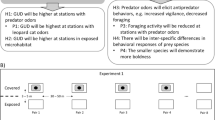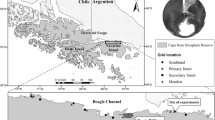Summary
Researchers have documented microhabitat partitioning among the heteromyid rodents of the deserts of North America that may result from microhabitat specific predation rates; large/bipedal species predominate in the open/risky microhabitat and small/quadrupedal species predominate in the bush/safer microhabitat. Here, we provide direct experimental evidence on the role of predatory risk in affecting the foraging behavior of three species of heteromyid rodents: Arizona pocket mouse (Perognathus amplus; small/quadrupedal), Bailey's pocket mouse (P. baileyi; large/quadrupedal), and Merriam's kangaroo rat (Dipodomys merriami; large/bipedal). Both kangaroo rats and pocket mice are behaviorally flexible and able to adjust their foraging behavior to nightly changes in predatory risk. Under low levels of perceived predatory risk the kangaroo rat foraged relatively more in the open microhabitat than the two pocket mouse species. In response to the presence of barn owls, however, all three species shifted their habitat use towards the bush microhabitat. In response to direct measures of predatory risk, i.e. the actual presence of owls, all three species reduced foraging and left resource patches at higher giving up densities of seeds. In response to indirect indicators of predatory risk, i.e. illumination, there was a tendency for all three species to reduce foraging. The differences in morphology between pocket mice and kangaroo rats do appear to influence their behavioral responses to predatory risk.
Similar content being viewed by others
References
Belman KL, Kranse FB (1983) Adaptive complexity of interactions between feeding and escape in crayfish. Science 221:779–781
Bowers MA, Brown JH (1982) Body size and coexistence in desert rodents: chance or community structure? Ecology 63:391–400
Brown JH (1973) Species diversity of seed eating desert rodents in dune habitats. Ecology 54:775–787
Brown JH, Lieberman G (1973) Resource utilization and coexistence of seed-eating rodents in sand dune habitats. Ecology 54:788–797
Brown JS (1986) Coexistence on a resource whose abundance varies: a test with desert rodents. Unpublished PhD Dissertation, Univ Arizona, Tucson, 231 pp
Brown JS (1988) Patch use as an indicator of habitat preference, predation risk, and competition. Behav Ecol Sociobiol 22:37–47
Brownlee KA (1965) “Statistical Theory and Methodolog in Science and Engineering, 2nd Edition”. Wiley, New York, New York
Calder WA III (1984) “Size, Function, and Life History”. Harvard Univ Press, Cambridge, Massachusetts
Charnov EL, Orians GH, Hyatt K (1976) Ecological implications of resource depression. Amer Natur 110:247–259
Clarke JA (1983) Moonlight's influence on predator/prey interactions between short-eared owls (Asio flammeus) and deermice (Peromyscus maniculatus). Behav Ecol Sociobiol 13:205–209
Dice LR (1945) Minimum intensities of illumination under which owls can find dead prey by sight. Amer Natur 79:385–416
Dice LR (1947) Effectiveness of selectivity by owls of deer mice (Peromyscus maniculatus) which contrast with their color background. Contr Lab Vert Biol Univ Mich No 34 20 pp
Edwards J (1983) Diet shifts in the moose due to predator avoidance. Oecologia (Berlin) 60:185–189
Eisenberg JF (1963) The behavior of heteromyid rodents. Univ Calif Publ Zool Vol 69, iv + 100 pp
Frye RJ (1983) Experimental field evidence of interspecific agression between two species of kangaroo rats (Dipodomys). Oecologia (Berlin) 47:323–327
Holt RD (1984) Spatial heterogeneity, indirect interactions, and the coexistence of prey species. Amer Nat 124:377–406
Hurlbert SH (1984) Pseudoreplication and the design of ecological field experiments. Ecol Monogr 54:187–211
Ives AR, Dobson AP (1987) Antipredator behavior and the population dynamics of simple predator-prey systems. Amer Natur 130:431–447
Kerfoot WC, Sih A, eds. (1987) “Predation, Direct and Indirect Impacts on Aquatic Systems”. University Press of New England, Hanover, New Hampshire
Kotler BP (1984) Risk of predation and the structure of desert rodent communities. Ecology 65:689–701
Kotler BP, Holt RD (1988) Predation and competition: the interaction of two types of species interaction. Oikos (in press)
Langeford A (1983) Pattern of nocturnal activity of male Dipodomys merriami (Heteromyidae). Southwest Natur 28:341–346
Lima SL, Valone TJ, Caraco T (1985) Foraging efficiency-predation risk tradeoff in the gray squirrel. Anim Behav 33:155–165
Lockard RB, Owings DH (1974) Seasonal variation in moonlight avoidance by bannertail kangaroo rats. J Mammal 55:189–193
Milinski M, Heller R (1978) Influence of a predator on the optimal foraging behaviour of sticklebacks (Gasterosteus aculeatus L.). Nature 275:642–644
Ohman MD, Frost BW, Cohen EB (1983) Reverse diel vertical migration: an escape from invertebrate predators. Science 220:1404–1407
Peckarsky BL, Dodson SI (1980) Do stonefly predators influence benthic distributions in streems? Ecology 61:1275–1282
Price MV (1978) The role of microhabitat specialization in structuring desert rodent communities. Ecology 58:1393–1399
Price MV, Waser NW, Bass TA (1984) Effects of moonlight on microhabitat use by desert rodents. J Mammal 65:353–356
Rosenzweig ML (1973) Habitat selection experiments with a pair of coexisting heteromyid rodent species. Ecology 62:327–335
Rosenzweig ML, MacArthur RT (1963) Graphic representation and stability conditions of predator-prey interactions. Amer Nat 97:209–223
Rosenzweig ML, Winakur J (1969) Population ecology of desert rodent communities: habitat and environmental complexity. Ecology 50:558–572
Sih A (1980) Optimal behaviour: can foragers balance two conflicting demands? Science 210:1041–1043
Sih A (1982) Foraging strategies and the avoidance of predation by an aquatic insect, Notonecta hoffmanni. Ecology 63:786–796
Simberloff D, Boecklen W (1981) Santa Rosalia reconsidered: size ratios and competition. Evolution 35:1206–1228
Thompson SD (1982) Microhabitat utilization and foraging behavior of bipedal and quadrupedal heteromyid rodents. Ecology 63:1303–1312
Thompson SD, MacMillen RE, Burke EM, Taylor CR (1980) The energetic cost of bipedal hopping in small mammals. Nature 287:223–224
Webster DB (1962) A function of the enlarged middle ear cavities of the kangaroo rat, Dipodomys. Physiol Zool 35:248–255
Webster DB, Webster M (1971) Adaptive value of hearing and vision in kangaroo rat predator avoidance. Brain Behav Evol 4:310–322
Werner EE, Gilliam JF, Hall DJ, Mittlebach GG (1983) An experimental test of the effects of predation risk on habitat use in fish. Ecology 64:1540–1548
Author information
Authors and Affiliations
Rights and permissions
About this article
Cite this article
Brown, J.S., Kotler, B.P., Smith, R.J. et al. The effects of owl predation on the foraging behavior of heteromyid rodents. Oecologia 76, 408–415 (1988). https://doi.org/10.1007/BF00377036
Received:
Issue Date:
DOI: https://doi.org/10.1007/BF00377036




